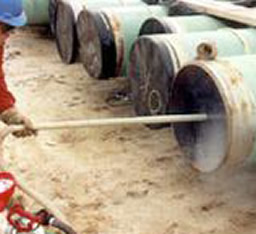Chemical Treatment is an important corrosion mitigation methodology. It is often referred to as corrosion inhibition, which is most commonly utilised in an aqueous environment. Chemical treatment may also be used in high temperature, non-aqueous environments in some unusual cases. The substance which retards corrosion, while beining added to the environment in small concentrations, is called ‘corrosion inhibitor’. It functions by
1) Adsorption as a thin film
2) By forming a barrier to corrosion products
3) By modifying the corrosive environment
4) A combination of either of the 3 above
Some tend to categorise the corrosion inhibitors by their role in the corrosion electrochemical process. In this method, the corrosion inhibitors can be classified as:
1) Anodic
2) Cathodic
3) Mixed
In general , the effectiveness of chemical treatment is largely determined by:
1) The method of applying chemicals (slug/continuous)
2) Process conditions (fluid chemistry, temperature, velocity, sediments, etc)
3) Materials of construction (bill of materials, welding methods)
4) Pre-existing corrosion conditions
5) Chemical availability
It is worth noting that corrosion inhibition is not the only chemical treatment option in corrosion engineering. Microbial treatment, oxygen/H2S scavenge, scale inhibition, emulsion and hydrate inhibition are other common chemical treatment options to mitigate corrosion in the system.
The methods for corrosion inhibitor deployment
Continuous Treatment
The corrosion inhibitors are applied in oil wells and surface facilities by a chemical proportioning pump. The normal practice begins with high concentration to produce a persistent inhibitor film on the metal surface. The inhibitor film is maintained and replenished with continuous lower concentration chemical dosing. The chemical concentration can be as low as 25 to 100 ppm. At these low levels, solubility, dispersability and miscibility of the corrosion inhibitors would be easily obtained.
Intermittent Treatment (Batch treatment)
The corrosion inhibitor film is achieved by batch dosing of large quantities of inhibitor for better corrosion protection and economic benefits. In practice, regular treatment intervals may vary from 3 to 6 months. Higher concentration corrosion inhibitors (percentage range) are usually used in batch treatment. The chemicals are formulated in such a way that corrosion inhibitors can be easily delivered to the desired location. Weighting agents, immissicribilising agent and mutual solvent are most common components in these formulations. Corrosion inhibitors may also be formulated as solid sticks, encapsulate and pellets for downhole treatment. Batching treatment with heavy liquid inhibitors can be an option for wells that are easily killed. The other available option is dosing with a small aperture downhole tubing string.
Squeeze Treatment
This is a downhole treatment for wells with porous strata. The objective is to achieve a continuous release of corrosion inhibitors with production fluid. High concentrations of inhibitors are driven into formation with pressurised dale gas, LPG or nitrogen intermittently. The flowback fluid during later production will carry certain amounts of corrosion inhibitors and render corrosion protection for extended periods of time. The side effect of squeeze treatment is an emulsifying of the production fluid and damage to the reservoir. Field experience shows that the squeeze practice may be repeated many times and the second and later batches normally have greater effectiveness and longer life span than that of the first squeeze.
Tubing displacement treatment
This is a variant of squeeze treatment, in which corrosion inhibitors are not squeezed into formation. It involves the full contact of the tubing surface with corrosion inhibitors to achieve persistent film of corrosion inhibitors. Tubing, annulus, casing, pump parts, rods and valves are all effectively protected by corrosion inhibitors contained in the flow back fluid.
Flotation Technique
It is normally used in oil tankers since the storage tank is also utilised as a ballast tank. Flotation inhibitors are applied in the oil phase which is on the top of water. The exposed steel contacts with the inhibitor when water is pumped in and out. Due to the large volume of liquid, the inhibitor has to be applied efficiently to make it economically viable.
Fogging
Most used in tank & piping for preservation purposes. A finely atomised spray or fog of the inhibitor is carried by air/nitrogen/steam to cover all internal areas. Recently, the fogging technique is also widely adopted to deploy vapour phase corrosion inhibitor (VpCI)
More field experience and discussion can be viewed at my Chemical Treatment Blog.

